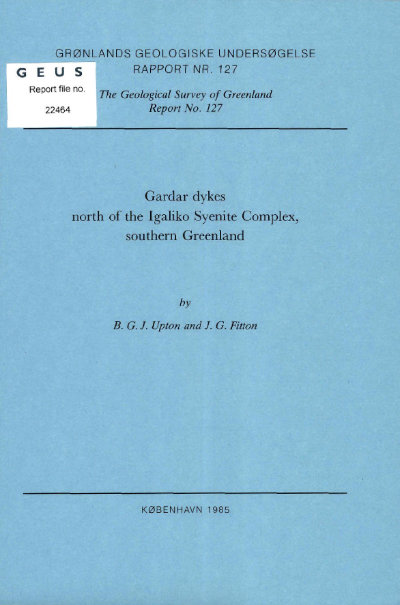Gardar dykes north of the Igaliko Syenite Complex, southern Greenland
DOI:
https://doi.org/10.34194/rapggu.v127.7919Abstract
An ENE-WSW trending swarm of Gardar dykes, traversing Mellemlandet and G. E Holm Nunataq is principally composed of a 'main series' with compositions ranging from alkali olivine basalt to trachyte and rhyolite, and scarcer phonolitic trachyte associates. The most basic 'main series' magmas were emplaced as several giant dykes up to 650 m wide. Synformally layered gabbroic and anorthositic cumulates are locally developed within these. At Syenitknold internal differentiation within a giant dyke gave rise to syenogabbros, layered syenite cumulates and peralkaline nepheline syenite pegmatites. A large xenolithic mass of exotic feldspathic gabbro within the syenites is ascribed to the foundering of feldspar-rich roofing facies into the underlying magma chamber. Less extreme differentiation in the same giant dyke east of Syenitknold produced syenogabbroic cumulates containing evidence for vigorous convective flow having developed in the cooling intrusion. Smaller (< 40 m wide) and younger dykes are almost invariably of more differentiated character. The commonest dykes ( < 15 m wide) are of benmoreite and trachyte. Dykes with their interiors crowded with plagioclase xenocrysts and anorthositic inclusions are referred to as 'big feldspar dykes' (B.F.D.s). While all compositions from basalt to benmoreite may be involved in the B.F.D.s, the B.F.D. character is typical of the hawaiites and mugearites. Small (typically < 1 m), scarce dykes and sills of highly silica-undersaturated types range from ultramafic lamprophyres to carbonatites. These may be representative of a compositional continuum between 36 and 2 wt % SiO2,. The main swarm is so closely similar to that seen to the WSW, extending through Tugtutoq and the Narssaq and Qagssiarssuk areas, that it is thought to be merelya faulted continuation ofthe latter. Itso, this swarm, c. 15 km across, is at least 140 km long. The magnitude and extent of this alkaline swarm and its individual components, may well be unique: it differs from other swarms (e.g. that of the roughly contemporaneous Nunarssuit-Isortoq swarm) in the size and abundance of the salic dykes within it. It was almost certainly related to extensive fissure eruption of basic to salic lavas. A clockwise change of several degrees between the orientation of early giant dykes and later differentiated dykes is related to a change in the extensional stress direction during the development of the Gardar rift system.
Downloads
Published
Issue
Section
License
This article is distributed under a CC-BY 4.0 licence, permitting free redistribution and reproduction for any purpose, even commercial, provided proper citation of the original work. Author(s) retain copyright over the article contents.


